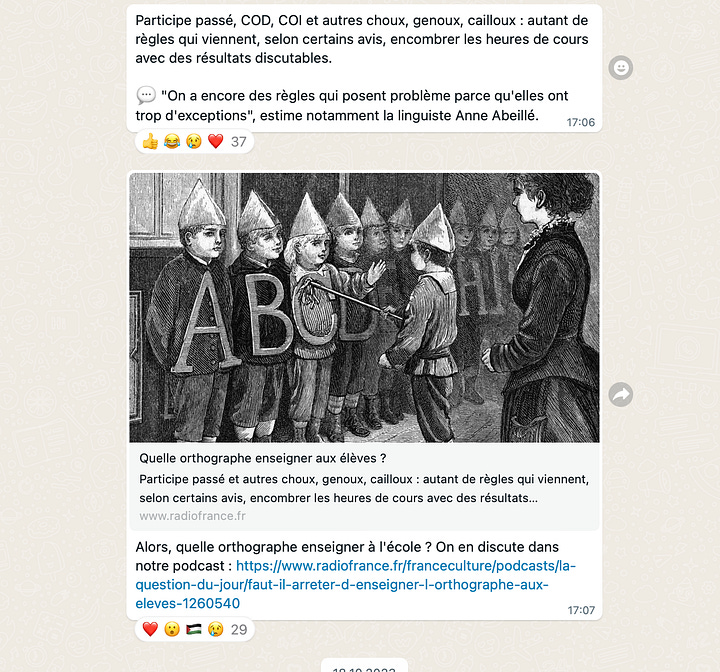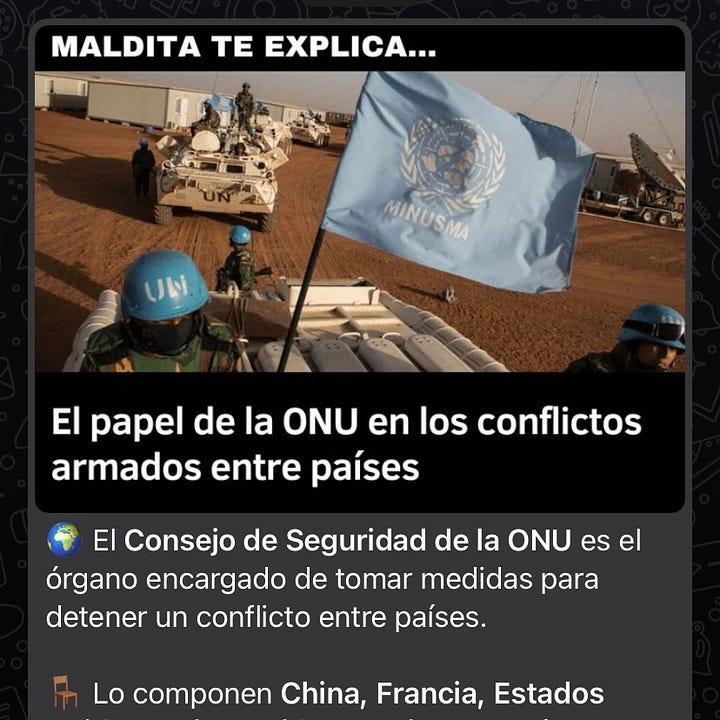WhatsApp, Europe?: How news outlets are using Channels
Plus: Tips on how to bring more humanity to journalism - And Other Inspiring Ideas From Across Europe
👋 Hey there fellow curious journalists,
thanks so much for coming on this email-ride - curating interesting bits and pieces from journalism all over Europe (and occasionally beyond).
🤓A small FYI: Because of my work I have a bias towards all things strategy and visual storytelling. But this newsletter (and me) is a work-in-progress, so with each edition I’ll try to a) expand my perspective and b) cover more and more countries.
🇪🇺What’s App, Europe?
🚀 100.000 followers in just a few hours: tagesschau, Germany’s most watched news program, very successfully launched their WhatsApp channel in mid-October. By now over 390.000 receive their messages. WhatsApp users definetly seem to be curious about the new feature.
🕵️ A good reason to take a look at what other media companies in Europe are doing on WhatsApp. In the last week, I scrolled through media channels from Germany, France, Italy, Spain and the UK:


👀 Here’s what I noticed:
Topics: Most media companies have opened up general news channels - they either send out curated news summaries or multiple texts with (breaking) news.
Notable exceptions:
The Financial Times has two channels: One focused on market news (which makes sense given their brand) and one focused on the Israel-Hamas conflict. This is an interesting choice, as it goes against the feeling that users are already overwhelmed by content on the topic.
Correctiv, an investigative newsroom from Germany, fact-checks claims on their channel that have gone viral. This seems a good fit for the platform as most people are likely to receive fake-news through friends on WhatApp.
Maldita.es, a Spanish media outlet with a focus on disinformation, has two channels. One to warn and inform people about current schemes and phishing attempts online, and another focused on current events and fact-checking.
FOCUS, a German media company, has gone very niche - in addition to channels focused on health and business they also offer a separate channel dedicated to E-Bikes. And the Daily Mail has channels dedicated to Netflix news and the Royals.
Timing: Not many surprises here - media channels send their news roundups in the morning or the evening (or some both times). Only Wired Italia sends one at noon, to be read during the lunch break.
Those that send multiple news don’t seem to have a timing - texts are send whenever the news breaks (or when someone has time to hit the “publish” button).
💡I’m curious to see how the publishing time affects the reach of the Channels and at what number of texts users start to get overwhelmed.
Format: Channels with multiple news stories per day tend to use just one sentence and a link - like the BBC or Rai. Exceptions I spotted: Le Monde - the channel teases more in-depth pieces with platform-specific summaries - and El Pais - they use the three most interesting quotes to tease their interviews:




As for news summaries - most channels send them as a single text: Well structured with emojis and easy to digest at a glance. Often combined with an image, sometimes with a video.




Notable exceptions:
franceinfo - They send out an audio update in the morning, a longer and a shorter video recap in the evening. All three are “re-uses” - their audio update is a podcast, the longer video recap is from a YouTube format and the video recap seems to be the same material as in their Insta stories.
Brut. - The French media company sends out a video recap every evening, which is the same they also publish on their Insta reels.
Will Media - The Italian media company promotes its news recap podcast and then sends out three selected news stories of the day - in separate, longer texts.
France Culture: They pick one topic per day - it’s a broad range, from “orthography and grammar” to “corrected versions of famous tales” - and then send out several messages (texts and images). To focus only on one thing - that’s a strategy I haven't seen on any other channel. It certainly helps with the feeling of news overload that many people have.




Screenshots from France Culture and Maldita.es Maldita.es - The Spanish newsroom publishes throughout the day and has content categories. They signal the category to the audience by using different colors in the “cover pictures”.
Interaction: Options are limited - so far the channel audience can only leave emojis on posts. Channels are using them for Calls To Action and RFI publishes a daily quiz - asking users to vote via emoji. I haven’t seen channels communicate the results back to users or use them for anything else, like voting on further reporting.
After scrolling through all the channels …
🤔 Here’s what I’m wondering:
With news avoidance growing every year - why have most media companies chosen general news channels on WhatsApp?
We know this from countless studies: The way we select and report news is leaving more and more people frustrated, hopeless and anxious. And yet the news I saw curated on the channels wasn't much different from what users find on other platforms. I saw little to no constructive approaches.
What sets WhatsApp apart from other platforms is the ability to reach a really broad audience - from teens to grannies, across all backgrounds. And WhatsApp channels sit right next to our personal chats, where we share everyday joys, pains and sorrows with our loved ones.
🪄I can't help but feel that there's a lot of untapped potential here - to try something different, to cater more to needs that are not being met by traditional news coverage, and to reach audiences that are not well served.
It's still early days for the WhatsApp channels, so I'm keeping my fingers crossed for some different approaches. And I may have missed channels trying something really new - if you know of one, I'd love to hear about it!
📬 Also, if you're reading this and working on a WhatsApp channel - let me know what you think.
Oh hey, you are new here?
Hi, I’m Isabel, a journalist & digital strategist from Germany.
❤️ finding new ways of storytelling and developing formats for new platforms.
🙌 Goal for 2023: Knowing more about what my European colleagues are working on.
Come along on my journey in this newsletter:
“We’ve got personalities. We can take a position on an issue. We’ve got empathy. We can work with communities. We can listen to communities. We can witness what is happening. Machines cannot do that,”
👆This quote really resonated with me - as my focus at work right now is pretty evenly split between “How can we use AI in newsrooms?” and “How can we empathize more with our users?”.
💓 So how can we bring more humanity to our Journalism?
Here are some ideas for action I’ve come across in the last weeks:
1️⃣ Find out who we’re neglecting and focus on them: The News for All project is about connecting with vulnerable communities that traditionally have not been well served by mainstream journalism. They’ve just started on their journey - you can follow their findings here.
2️⃣ Immerse yourself with the people you want to reach: This NYT reporter followed 13-year-old teens (in the USA) around and offers a fascinating dive into their lives and needs.
3️⃣ Combine learnings with technology to create empathy: The Dutch project 'Bubble Games' used Virtual Reality to help people better understand points of view different from their own. And it worked!
4️⃣ Ask different questions: We can cultivate hope in our reporting by being more selective about the questions we ask. For ex.: Instead of only inquiring “When did the aggressions start?”, also ask: “When was the last time this community’s members felt close and connected?”. This approach is called “Appreciative Inquiry” and the Bonn Institute published a neat introduction to it here.
🤖 And for those of you with the other eye on AI:
👉 What Generative AI can do for your storytelling: This is still one of the best overviews I’ve seen of what you can do with Generative AI in a newsroom - from BBCs David Caswell.
👉 72 practical Slides on AI & Strategy: Speaking of good overviews - Ezra Eeman, Director of Strategy & Innovation at NPO, the Dutch Public Broadcaster, has published his presentation from the Dutch Media Week on LinkedIn. It’s in Dutch, but you can upload the .pdf to Google Translator and read it in your preferred language. It’s definitely worth the effort.
👉 To block or not to block AI crawls - that’s the question most publishers are discussing right now. Here is a neat, automatically updated overview of who is blocking OpenAI, Google AI and Common Crawl.
🫶 Yay, you’ve made it this far - thanks so much for scrolling all the way through!
👆Did you enjoy this issue? Then feel free to spread the newsletter-lover! 💌
🌐Sidenote: If you are wondering: How can I read up on all theses examples in a foreign language? There is this fitting quote I overheard:
“The language of Europe is translation.”
Luckily, translation has gotten quite easy: Nearly every browser has a neat translation function (or an add-on available), a lot of email providers too and there is of course your favourite AI tool to help out.
I’d be very lost in Journalism-Europe without good sources - so for this edition many 💞 go out to Bonn Institute, the PressGazette and datagif.
👋 That’s all - for now.
Stay curious out there,
Isabel
*This newsletter was made with lots of ❤️ and a bit of help by AI for better flow and translations.*


